Insurance access in adults with congenital heart disease in the Affordable Care Act era
Funding information: None
Abstract
Background
Adults with congenital heart disease (ACHD) have traditionally been viewed as an underinsured population. Whether this is true in the Affordable Care Act era is unknown. We determined insurance patterns in ACHD patients compared to the non-ACHD cardiology population in a contemporary cohort.
Methods
All cardiology outpatient visits between July 2016 and February 2017 to a large referral center in the United States were reviewed. The primary payer was categorized as health maintenance organization (HMO), preferred provider organization (PPO), Medicare, Medicaid, self-pay, or other. Diagnosis and lesion severity of ACHD were extracted from ICD-10 diagnostic codes and assigned according to the 2008 American College of Cardiology/American Heart Association ACHD guidelines. Age-matching was used to account for baseline age differences between ACHD and non-ACHD patients.
Results
E ACHD and 17 154 non-ACHD patients were identified. Without age-matching, ACHD patients were significantly younger than non-ACHD patients (mean age 38.5 vs 63.8 years). After age-matching (N = 805 in each group), mean age was 39.5 years in both groups. ACHD patients had less HMO (29.1% vs 34.7%, P = .012) and Medicaid (12.4% vs 17.3%, P = .006) coverage, but more PPO (34.4% vs 27.5%, P = .003) and Medicare (23.2% vs 18.1%, P = .005) coverage compared to non-ACHD patients. No differences were found in private insurance, public insurance, or self-pay. Lesion complexity had no effect on insurance in ACHD patients. Eligibility of parental plan coverage did not affect use of private insurance. ACHD patients in states with Medicaid expansion had higher rates of Medicaid (15.6% vs 10.6%, P = .045) but lower rates of HMO coverage (24.5% vs 31.7%, P = .036) and self-pay (0% vs 3.3%, P < .001). ACHD status, age, income, and residence in Medicaid expansion states were independent determinants of insurance types.
Conclusions
In the Affordable Care Act era, ACHD patients are a well-insured population. Governmental policy has substantial effects on individual-level choice and access to insurance.
CONFLICT OF INTEREST
None.




